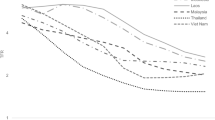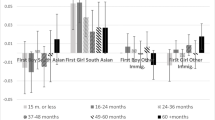Abstract
Although it is widely acknowledged that the preference for sons is a barrier to a decline in fertility, considerable disagreement exists as to what actually happens to this preference when fertility declines in a region of low female autonomy. By analyzing the data from the National Family Health Survey (NFHS), we present evidence from northern India to show that the preference for sons is reduced when the ideal family size becomes small, even though it does not completely disappear. This finding appears to contradict trends in the juvenile sex ratio and the incidence of female feti-cide that suggest the intensification of gender bias. We argue that the anomaly is the result of a diffusion of prenatal sex-diagnostic techniques in regions where there is a large unmet demand for such methods. Using the NFHS data, we estimate that in northern India, girls currently constitute about 60% of the unwanted births and that the elimination of unwanted fertility has the potential to raise the sex ratio at birth to 130 boys per 100 girls.
Similar content being viewed by others
References
Agnihotri, S.B. 2000. Sex Ratio Patterns in the Indian Population: A Fresh Exploration. New Delhi: Sage.
Arnold, F., M. Kim Choe, and T.K. Roy. 1998. “Son Preference, the Family Building Process and Child Mortality in India.” Population Studies 52:302–15.
Basu, A.M. 1992. Culture, the Status of Women and Demographic Behaviour: Illustrated With the Case of India. Oxford, England: Clarendon Press.
Bhat, P.N.M. 1998. “Emerging Regional Differences in Fertility in India: Causes and Correlations.” Pp. 131–68 in Reproductive Change in India and Brazil, edited by G. Martine, M. Das Gupta, and L.C. Chen. Delhi: Oxford University Press.
— 2002a. “On the Trail of ‘Missing’ Indian Females.” (Published in two parts) Economic and Political Weekly 37:5105–118, 5244–63.
— 2002b. “Returning a Favor: Reciprocity Between Female Education and Fertility in India.” World Development 30(10):1701–803.
Bhat, P.N.M., and F. Zavier. 1999. “Findings of National Family Health Survey: Regional Analysis.” Economic and Political Weekly 34:3008–32.
Bhat, P.N.M. 2001. “Fertility Decline and Gender Bias in Northern India.” Paper presented at the Twenty-fourth General Conference of the IUSSP at Salvador, Brazil, August 18–24, and circulated as Discussion Paper No. 33 of the Institute of Economic Growth, Delhi.
Cain, M.T. 1983. “Fertility as an Adjustment to Risk.” Population and Development Review 9: 688–702.
Clark, S. 2000. “Son Preference and Sex Composition of Children: Evidence From India.” Demography 37:95–107.
Coale, A.J. 1991. “Excess Female Mortality and the Balance of the Sexes in the Population: An Estimate of the Number of Missing Females.” Population Development Review 17:517–23.
Das, N. 1987. “Sex Preference and Fertility Behaviour: A Study of Recent Indian Data.” Demography 24:517–30.
Das Gupta, M. 1987. “Selective Discrimination Against Female Children in Punjab, India.” Population Development Review 13:77–100.
Das Gupta, M. and P.N.M. Bhat. 1997. “Fertility Decline and Increased Manifestation of Sex Bias in India.” Population Studies 51:307–15.
Dreze, J. and M. Murthi. 2001. “Fertility, Education and Development: Evidence From India.” Population and Development Review 27:33–63.
Dyson, T. and M. Moore. 1983. “On Kinship Structure, Female Autonomy and Demographic Behaviour in India.” Population and Development Review 9:35–60.
Griffiths, P., Z. Matthews, and A. Hinde. 2000. “Understanding the Sex Ratio in India: A Simulation Approach.” Demography 37:477–87.
Guillot, M. 2002. “The Dynamics of the Population Sex Ratio in India, 1971–96.” Population Studies 56:51–63.
Guilmoto, C.Z. and S.I. Rajan. 2001. “Spatial Patterns of Fertility Transition in Indian Districts.” Population and Development Review 27:713–38.
International Institute for Population Sciences (IIPS). 1995. National Family Health Survey, India 1992–93. Mumbai: IIPS.
International Institute for Population Sciences (IIPS) and ORC Macro. 2000. National Family Health Survey (NFHS-2), India 1998–99. Mumbai: IIPS.
Jejeebhoy, S.J. 2001. “Women’s Autonomy and Reproductive Behaviour in India.” Pp. 221–41 in Fertility Transition in South Asia, edited by Z.A. Sathar and J.F. Phillips. Oxford, England: Oxford University Press.
Karve, I. 1965. Kinship Organization in India. Mumbai: Asia Publishing House.
Kishor, S. 1993. “May God Give Sons to All: Gender and Child Mortality in India.” American Sociological Review 58:247–65.
Klasen, S. 1994. “‘Missing Women’ Reconsidered.” World Development 22:1061–71.
Kulkarni, P.M. 1999. “Gender Preference and Contraceptive Prevalence: Evidence of Regional Variations.” Economic and Political Weekly 34:3058–62.
Lightbourne, R.E. 1985. “Desired Number of Births and Prospects for Fertility Decline in 40 Countries.” International Family Planning Perspectives 11:34–39.
Malhotra, A., R. Vanneman, and S. Kishor. 1995. “Fertility, Patriarchy and Development in India.” Population and Development Review 21:281–305.
Mason, K. Oppenheim. 1984. The Status of Women: A Review of Its Relationship to Fertility and Mortality. Ann Arbor: Population Studies Center, University of Michigan.
—. 1993. “The Impact of Women’s Position on Demographic Change During the Course of Development.” Pp. 19–42 in Women’s Position and Demographic Change, edited by N. Federici, K. Oppenheim Mason, and S. Sogner. Oxford, England: Clarendon Press.
Mayer, P. 1999. “India’s Falling Sex Ratios.” Population and Development Review 25:323–43.
Miller, B.D. 1981. The Endangered Sex: Neglect of Female Children in Rural North India. Ithaca, NY: Cornell University Press.
Murthi, M., A.-C. Guio, and J. Dreze 1995. “Mortality, Fertility and Gender Bias in India.” Population Development Review 21:745–82.
Mutharayappa, R., M. Kim Choe, F. Arnold, and T.K. Roy. 1997. “Son Preference and Its Effect on Fertility in India.” National Family Health Survey, Subject Report No. 3. Mumbai: IIPS.
Registrar General, India. 2001. Provisional Population Totals. Census of India 2001, Paper 1 of 2001. Delhi: Controller of Publications.
Sen, A. 1990. “More Than 100 Million Women Are Missing.” New York Review of Books 20(December): 61–66.
Srinivas, M.N. 1989. The Cohesive Role of Sanskritization and Other Essays. Delhi: Oxford University Press.
Srinivasan, K. 1995. Regulating Reproduction in India’s Population: Efforts, Results and Recommendations. New Delhi: Sage.
Sudha, S. and S. Irudaya Rajan. 1999. “Female Demographic Disadvantage in India, 1981–1991: Sex Selective Abortions and Female Infanticide.” Development and Change 30:585–618.
United Nations 1995. “Program for Action of the 1994 International Conference on Population and Development (Chapters I–VIII).” Population and Development Review 21:187–213.
Williamson, N.E. 1976. Sons and Daughters: A Cross-Cultural Study of Parental Preferences. Beverly Hills, CA: Sage.
Author information
Authors and Affiliations
Additional information
An earlier version of this paper was presented at the 24th General Population Conference of the International Union for the Scientific Study of Population held in Salvador, Brazil, August 18-24, 2001, and circulated as a discussion paper of the Institute of Economic Growth, Delhi. We wish to thank Sabu George for his useful discussion and anonymous reviewers for their helpful comments.
Rights and permissions
About this article
Cite this article
Bhat, P.N.M., Zavier, A.J.F. Fertility decline and gender bias in. Demography 40, 637–657 (2003). https://doi.org/10.2307/1515201
Issue Date:
DOI: https://doi.org/10.2307/1515201




